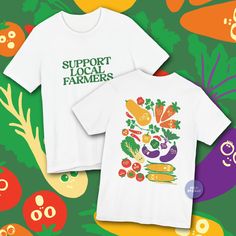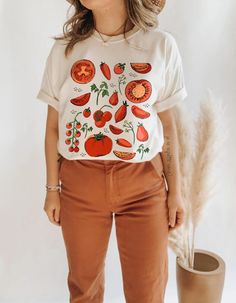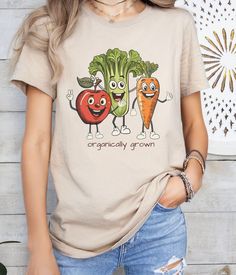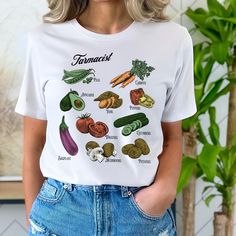Vegetable Impression on T-shirt
Vegetable printing is an eco-friendly and creative way to design and decorate fabric, including T-shirts. This technique involves using vegetables like potatoes, okra, celery, carrots, and other textured produce to create unique patterns and impressions on fabric. Vegetable printing, being a simple yet artistic approach, can turn a plain T-shirt into a personalized piece of wearable art.
This note covers the materials needed, step-by-step instructions, types of vegetables used, tips for successful printing, and the significance of this method in promoting sustainability and creativity.

Why Vegetable Printing?
- Eco-Friendly: Vegetable printing aligns with environmentally conscious fashion. It uses natural resources that are biodegradable and reduces dependence on synthetic dyes or chemical printing processes.
- Affordability: You can find vegetables at a local grocery store or even in your kitchen, making this a cost-effective technique.
- Creativity and Customization: This method allows for endless creativity. You can mix and match vegetables to create abstract designs, floral patterns, geometric shapes, or random splashes of color.
- Learning Opportunity: Vegetable printing encourages learning about textures, colors, and design principles. It’s a great activity for children, students, and even adults interested in DIY projects.
Materials Needed:
To get started with vegetable printing on T-shirts, you’ll need the following materials:
- Plain T-shirt: Cotton or other natural fabrics work best as they absorb the paint better than synthetic materials.
- Vegetables: Potatoes, carrots, okra, celery, capsicum, mushrooms, etc.
- Fabric Paint or Acrylic Paint: Fabric paint is designed for textiles, while acrylic paint can also be used, though fabric medium should be mixed with it to ensure flexibility and durability.
- Sharp Knife: To cut and carve the vegetables into shapes or patterns.
- Palette or Plate: For mixing and holding the paint.
- Sponge or Paintbrush: To apply the paint onto the vegetable before stamping.
- Newspaper or Cardboard: To place inside the T-shirt to prevent paint from seeping through.
- Water and Paper Towels: For cleaning up excess paint and washing the vegetables after use.

Step-by-Step Guide:
- Prepare the T-shirt:
- Wash the T-shirt beforehand to remove any dirt, oils, or chemicals that may interfere with the paint’s adhesion.
- Iron the T-shirt to ensure a smooth surface for printing.
- Lay the T-shirt flat on a table and insert a piece of cardboard or newspaper inside the T-shirt to prevent paint from bleeding onto the back of the fabric.
- Select the Vegetables:
- Choose vegetables with interesting shapes or textures. For example, okra has a beautiful star-like pattern when cut, while celery stalks can be used to create a rose-like print.
- Cut the vegetables cleanly with a sharp knife. The cuts should be smooth so that the vegetable surface stamps cleanly onto the fabric.
- You can carve simple shapes or patterns into a potato, turning it into a customized stamp.
- Prepare the Paint:
- Pour a small amount of fabric paint onto a palette or plate. If using acrylic paint, mix it with a fabric medium to ensure it bonds well with the T-shirt fibers and remains soft after drying.
- Using a sponge or paintbrush, apply a thin layer of paint onto the cut surface of the vegetable. Be careful not to oversaturate it, as this can cause smudging.
- Stamp the T-shirt:
- Gently press the painted vegetable onto the T-shirt in your desired location. You can use light pressure for a more faded effect or firmer pressure for bold, solid prints.
- Experiment with different angles and orientations to create a dynamic pattern. You can repeat one type of vegetable for uniformity or mix several to create a varied design.
- Lift the vegetable gently after stamping to avoid smearing the paint.
- Let it Dry:
- After you’ve finished printing, allow the T-shirt to air dry completely. Follow the manufacturer’s instructions for drying time.
- Once dry, heat-set the paint by ironing the T-shirt on a low setting. Place a cloth between the iron and the painted area to protect the design.
- Finishing Touches:
- If desired, add additional hand-painted details to the design using fabric markers or small paintbrushes.
- You can layer different colors or overlap prints to create more complexity in your design.
Types of Vegetables and Their Impressions:

- Potatoes: Potatoes are versatile and easy to carve. They have a flat surface that allows for a variety of custom shapes. You can carve stars, circles, or even intricate designs to stamp onto the fabric.
- Okra: Okra, when sliced horizontally, reveals a unique star-like pattern. It creates beautiful, organic shapes that can be stamped to form a floral design or abstract print.
- Celery Stalks: The bottom end of a celery stalk, when dipped in paint and stamped, resembles a blooming rose. This is a popular choice for creating floral patterns on fabric.
- Carrots: When cut crosswise, carrots can produce circular shapes that can be used to create polka-dot patterns or arranged in clusters for a fun design.
- Bell Peppers: When sliced horizontally, bell peppers create a flower-like shape that can be used to form a natural, garden-inspired pattern.
Tips for Successful Vegetable Printing:
- Test First: Before stamping onto the T-shirt, test the vegetable stamp on a scrap piece of fabric or paper. This allows you to check how much paint to apply and how the print will look.
- Use a Variety of Colors: Mixing and layering different colors can add depth to your design. Don’t hesitate to use multiple shades to give a more vibrant and eye-catching look.
- Care for Your Stamps: Wash the vegetable stamps frequently if you’re using them with multiple colors. This will prevent unwanted color mixing and keep the prints sharp.
- Plan Your Design: Before printing, visualize or sketch out how you want the final design to look. This can help guide your placement of stamps and ensure you’re satisfied with the end result.

Significance of Vegetable Printing in Fashion and Art:
- Sustainability: In an era of increasing environmental awareness, vegetable printing offers an alternative to industrial fabric decoration processes that often involve harmful chemicals and synthetic materials.
- Promoting Handicrafts: This technique keeps alive traditional craft methods, allowing individuals to engage in tactile, manual work rather than relying solely on technology.
- Personalization and Slow Fashion: Vegetable printing embodies the principles of slow fashion, where garments are crafted with care, creativity, and individual expression. Each T-shirt becomes a unique piece of art, fostering a deeper connection to the clothing.
- Educational Value: This technique is often used in educational settings to teach children and students about natural resources, the science of dyeing, and the beauty of creativity. It also encourages mindfulness about the origins of materials and sustainability in fashion.
Conclusion:
Vegetable printing on T-shirts is a fun, affordable, and eco-friendly way to personalize clothing. With just a few basic materials, it allows for boundless creativity and offers a hands-on method of engaging with both art and sustainable fashion. Whether used for personal projects or in educational contexts, vegetable printing is a technique that fosters creativity while promoting a mindful approach to clothing design.
